How Much Money Has The Federal Government Spent On The War On Drugs
The War on Poverty After 50 Years
The State of war on Poverty After fifty Years
September xv, 2014 14 min read Download Report
Summary
In his January 1964 State of the Union address, President Lyndon Johnson proclaimed, "This administration today, here and now, declares unconditional war on poverty in America." In the 50 years since that time, U.S. taxpayers have spent over $22 trillion on anti-poverty programs. Adjusted for inflation, this spending (which does not include Social Security or Medicare) is three times the cost of all U.S. war machine wars since the American Revolution. Even so progress against poverty, as measured by the U.S. Demography Bureau, has been minimal, and in terms of President Johnson's main goal of reducing the "causes" rather than the mere "consequences" of poverty, the War on Poverty has failed completely. In fact, a significant portion of the population is now less capable of cocky-sufficiency than information technology was when the War on Poverty began.
Key Takeaways
The lack of progress in building self-sufficiency since the starting time of the War on Poverty 50 years agone is due in major function to the welfare system itself.
By breaking down the habits and norms that pb to self-reliance, welfare generates a design of increasing intergenerational dependence.
The anti-union penalties should be removed from welfare programs, and long-term steps should be taken to rebuild the family in lower-income communities.
This week, the U.S. Census Bureau is scheduled to release its annual poverty report. The report will be notable because this year marks the 50th anniversary of the launch of President Lyndon Johnson'south War on Poverty. In his Jan 1964 Land of the Union address, Johnson proclaimed, "This administration today, here and at present, declares unconditional state of war on poverty in America."[1]
Since that time, U.Due south. taxpayers have spent over $22 trillion on anti-poverty programs (in constant 2012 dollars). Adjusted for inflation, this spending (which does not include Social Security or Medicare) is 3 times the cost of all military wars in U.S. history since the American Revolution. Despite this mountain of spending, progress against poverty, at least as measured by the government, has been minimal.
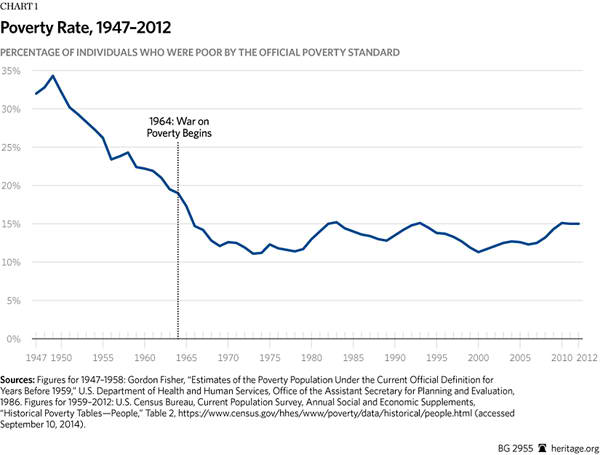
The Welfare–Poverty Paradox
This calendar week, the Census Bureau will nearly probable report that the poverty rate concluding yr was well-nigh 14 percent, essentially the same rate every bit in 1967, three years later the State of war on Poverty was appear. As Chart one shows, according to the Census, in that location has been no internet progress in reducing poverty since the mid to late 1960s. Since that fourth dimension, the poverty rate has undulated slowly, falling by 2 to iii percentage points during practiced economic times and ascension by a similar corporeality when the economy slows. Overall, the trajectory of official poverty for the by 45 years has been flat or slightly upward.
The static nature of poverty is specially surprising considering (as Chart i also shows) poverty fell dramatically during the menses before the War on Poverty began. In 1950, the poverty rate was 32.two pct. By 1965 (the first year during which any War on Poverty programs began to operate), the rate had been cut nearly in half to 17.iii percentage.[2]
The unchanging poverty rate for the past 45 years is perplexing because anti-poverty or welfare spending during that menstruum has simply exploded. As Nautical chart 2 shows, ways-tested welfare spending has soared since the start of the War on Poverty. In fiscal year 2013, the federal regime ran over 80 means-tested welfare programs that provided cash, food, housing, medical intendance, and targeted social services to poor and low-income Americans.
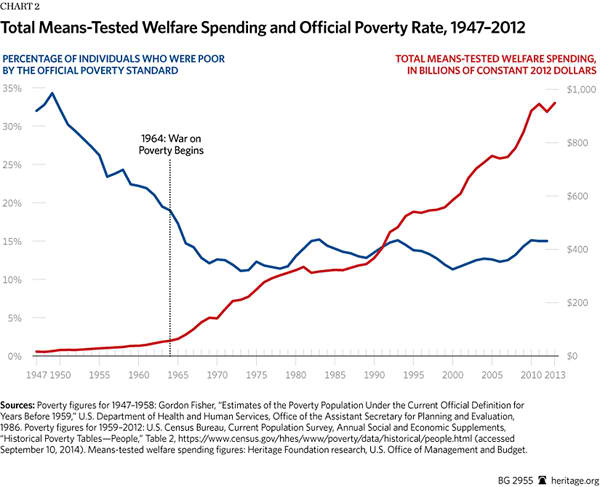
Overall, 100 meg individuals—most 1 in 3 Americans—received benefits from at least ane of these programs. Federal and land governments spent $943 billion in 2013 on these programs at an average cost of $nine,000 per recipient. (Again, Social Security and Medicare are not included in the totals.)
Today, authorities spends xvi times more, adjusting for inflation, on ways-tested welfare or anti-poverty programs than it did when the War on Poverty started. But as welfare spending soared, the reject in poverty came to a grinding halt. As Chart 2 shows, the more than the regime spent, the less progress confronting poverty was fabricated.
How tin can this paradox be explained? How tin can government spend $9,000 per recipient and have no credible impact on poverty? The reply is that it can't.
The conundrum of massive anti-poverty spending and unchanging poverty rates has a unproblematic explanation. The Census Bureau counts a family as "poor" if its income falls below specific thresholds,[three] just in counting "income," the Census omits well-nigh all of government means-tested spending on the poor.[four] In consequence, it ignores almost the unabridged welfare state when it calculates poverty. This neat bureaucratic ploy ensured that welfare programs could abound infinitely while "poverty" remained unchanged.
Living Conditions of the Poor in America[v]
Consumption by Poor Families. Since the Census Bureau dramatically undercounts the actual incomes of the poor, it should be no surprise to notice that the U.S. Department of Labor routinely reports that poor families spend $two.40 for every $1.00 of their reported income.[six] If public housing benefits are added to the tally, the ratio of consumption to income rises to $2.60 for every $1.00. In other words, the "income" figures that the Census Bureau uses to summate poverty dramatically undercount the economical resources available to lower-income households.
Amenities. Considering the official Census poverty report undercounts welfare income, information technology fails to provide meaningful information almost the actual living conditions of less flush Americans. The government'due south ain information show that the actual living weather condition of the more 45 million people deemed "poor" past the Census Agency differ greatly from popular conceptions of poverty.[7] Consider these facts taken from various government reports:[eight]
- Eighty percent of poor households have air-conditioning. By dissimilarity, at the beginning of the War on Poverty, simply about 12 percent of the unabridged U.S. population enjoyed air conditioning.
- Nearly three-quarters take a machine or truck; 31 percent have two or more cars or trucks.[9]
- Virtually 2-thirds have cable or satellite television.
- Ii-thirds have at to the lowest degree one DVD player, and a quarter have 2 or more.
- Half have a personal computer; one in seven has two or more computers.
- More than half of poor families with children have a video game system such every bit an Xbox or PlayStation.
- Twoscore-3 percent accept Internet access.
- Forty percent have a broad-screen plasma or LCD TV.
- A quarter accept a digital video recorder system such as a TIVO.
- Ninety-two percent of poor households have a microwave.
For decades, the living conditions of the poor have steadily improved. Consumer items that were luxuries or significant purchases for the center grade a few decades ago have become commonplace in poor households. In role, this is acquired past a normal downward price tendency following the introduction of a new product. Initially, new products tend to be expensive and available only to the affluent. Over time, prices fall sharply, and the product becomes widely prevalent throughout the population, including poor households. This is a full general sign of desirable economic progress.
Liberals use the declining relative prices of many civilities to argue that fifty-fifty though poor households have ac, computers, cable Idiot box, and wide-screen TVs, they however suffer from substantial material deprivation in basic needs such as food and housing. Here again, the data tell a different story.
Poverty, Nutrition, and Hunger. Despite impressions to the reverse, most of the poor do not experience undernutrition, hunger, or food shortages.[10] Information on these topics is collected past the household nutrient security survey of the U.S. Section of Agriculture. The USDA survey shows that in 2009:
- Ninety-6 percent of poor parents stated that their children were never hungry at any fourth dimension during the twelvemonth because they could not beget food.
- Some 83 percent of poor families reported that they had enough food to swallow.
- Some 82 percent of poor adults reported that they were never hungry at any fourth dimension in the prior year due to lack of money to buy food.
- As a group, America'due south poor are far from existence chronically undernourished. The average consumption of poly peptide, vitamins, and minerals is virtually the same for poor and middle-form children and in most cases is well above recommended norms. Poor children actually eat more meat than do college-income children and have average poly peptide intakes 100 percent to a higher place recommended levels.[11]
- Most poor children today are, in fact, supernourished and abound up to be, on average, i inch taller and ten pounds heavier than the GIs who stormed the beaches of Normandy in Earth War 2.[12]
Housing and Poverty. TV newscasts about poverty in America generally describe the poor as homeless or equally residing in dilapidated living conditions. While some families practice experience such astringent conditions, they are far from typical of the population defined as poor by the Census Bureau. The actual housing conditions of poor families are very different.[xiii]
- Over the course of a year, merely iv percent of poor persons become temporarily homeless. At a unmarried point in time, i in 70 poor persons is homeless.[14]
- But 9.5 percent of the poor live in mobile homes or trailers; 49.5 percent alive in split up single-family houses or townhouses, and 40 percent live in apartments.
- Forty-two percent of all poor households actually own their own homes. The boilerplate home endemic by persons classified every bit poor by the Census Bureau is a 3-chamber house with i-and-a-one-half baths, a garage, and a porch or patio.
- Only 7 pct of poor households are overcrowded. More than than two-thirds have more than two rooms per person.
- The average poor American has more than living space than the boilerplate individual living in Sweden, French republic, Frg, or the Great britain. (These comparisons are to the boilerplate citizens in foreign countries, non to those classified as poor.)[15]
- The vast majority of the homes or apartments of the poor are in adept repair and without significant defects.
Past his own report, the boilerplate poor person had sufficient funds to meet all essential needs and was able to obtain medical care for his family unit throughout the twelvemonth whenever needed.
Of grade, poor Americans exercise not live in the lap of luxury. The poor clearly struggle to make ends meet, merely they are generally struggling to pay for cable TV, air conditioning, and a car, also as nutrient for the table. The boilerplate poor person is far from affluent, merely his lifestyle is as far from the images of stark deprivation purveyed by advocacy groups and the mainstream media. The challenges become much deeper than a lack of material resources.
Was the War on Poverty a Success?
Exercise the higher living standards of the poor hateful that the War on Poverty has been successful? The answer is no, for two reasons. Offset, the incomes and living standards of less affluent Americans were rising rapidly well before the War on Poverty began. (See Charts ane and ii.)
Second, and more than important, to assess the State of war on Poverty, we must empathise President Johnson's actual goal when he launched it. The original goal of the War on Poverty was not to prop upwardly living standards artificially through an e'er-expanding welfare state. Instead, Johnson declared that his state of war would strike "at the causes, non just the consequences of poverty."[16] He added, "Our aim is non only to salvage the symptom of poverty, simply to cure it and, in a higher place all, to prevent it."[17]
In other words, President Johnson was not proposing a massive system of e'er-increasing welfare benefits, doled out to an always-enlarging population of beneficiaries. His proclaimed goal was not a massive new system of government handouts but an increase in self-sufficiency: a new generation capable of supporting themselves out of poverty without government handouts.
LBJ really planned to reduce, not increase, welfare dependence. He alleged, "Nosotros want to give the forgotten 5th of our people opportunity not doles."[xviii] He claimed that his state of war would enable the nation to make "of import reductions" in future welfare spending: The goal of the War on Poverty, he stated, would exist "making taxpayers out of taxeaters."[xix] Because he viewed the War on Poverty as a means to increment self-back up, Johnson proclaimed that it would be an "investment" that would "return its cost manifold to the entire economy."
Measuring Self-Sufficiency
How has the War on Poverty fared with respect to President Johnson'due south paramount goal of promoting self-sufficiency? What render take the taxpayers reaped from their $22 trillion "investment"? Paradoxically, the answers to these questions are best provided by the Demography Bureau's official poverty statistics.
As noted, Census poverty figures are misleading as a measure of actual living weather because they exclude most all welfare aid. They do, yet, provide a fairly accurate mensurate of a family'due south wages and earnings. This means that the official Census "poverty" figures are, in fact, a good measure of President Johnson'south original goal of promoting "cocky-sufficiency": the ability of a family to sustain itself above the poverty level through its own piece of work and investment without reliance on welfare help.
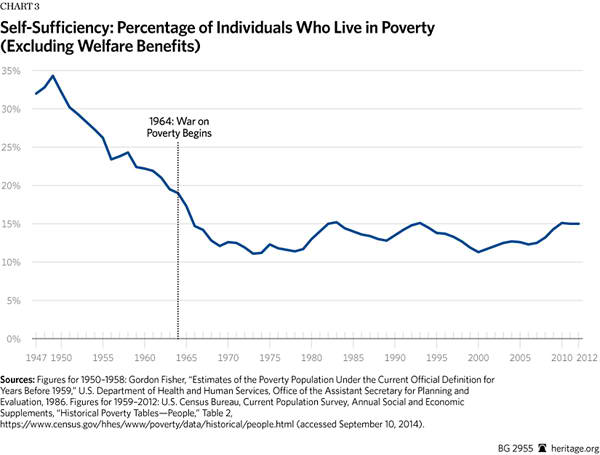
Chart three repeats the official Census "poverty" figures from Chart 1 but relabels them more than accurately as a "self-sufficiency" index. The story told by the chart is hitting.
In the decade and a half before the offset of the War on Poverty, low-income Americans experienced dramatic improvements in self-sufficiency. The share of Americans who lacked self-sufficiency was cutting nigh in half, falling from 32.ii percentage in 1950 to 17.3 percent in 1965.
During the commencement six years after Johnson appear the War on Poverty (1965 to 1970), self-sufficiency continued to better steadily. New government programs were initiated. Means-tested welfare spending increased sharply from $57 billion in 1964 to $141 billion (measured in constant 2012 dollars).
Some authors suggest that the continuing reject in official poverty from 1965 to 1970 demonstrates the initial success of the War on Poverty, but over xc percent of the increased spending during this menstruation was in the form of non-greenbacks benefits that the Census does not count for purposes of measuring poverty.[20] It is therefore impossible for the expansion of means-tested welfare to have directly produced the large decline in official poverty that occurred during this menstruum.
Programs that in theory could have reduced poverty indirectly by raising wages and employment were regarded as largely ineffective and were limited in telescopic. For example, in the tardily 1960s, only 300,000 participants per yr were enrolled in Job Corps and related training programs.[21]
Thus, it is implausible to suggest that the pass up in official poverty between 1965 and 1970 was due substantially to the directly or indirect effects of War on Poverty programs. Rather, official poverty declined and self-sufficiency improved for the same full general reason that these improvements occurred before 1965: a steady rise of wages and education levels.
Unfortunately, the situation inverse in the early 1970s. The steady improvement in self-sufficiency slowed and then came to a halt. For the next 4 decades, self-sufficiency has remained stagnant or has slightly worsened.
The large motion picture is clear: For xx years, from 1950 to 1970, cocky-sufficiency (and official poverty) improved dramatically. In the next 4 decades, there was no progress at all; the self-sufficiency rate remained essentially static. In terms of President Johnson's master goal of reducing the "causes" rather than the mere "consequences" of poverty, the War on Poverty has failed completely, despite $22 trillion in spending. In fact, a pregnant portion of the population is now less capable of cocky-sufficiency than information technology was when the War on Poverty began.
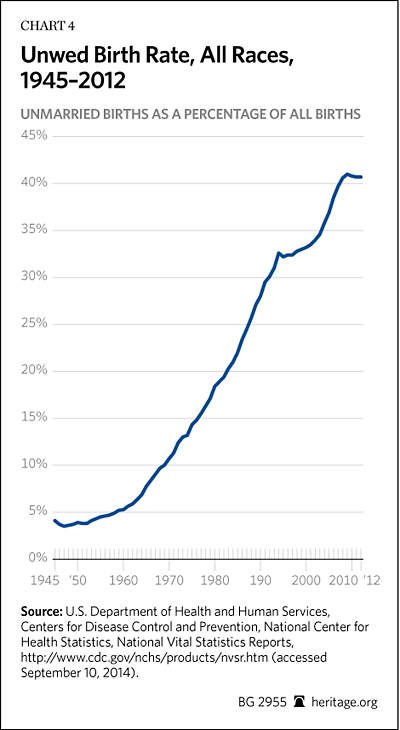
What Went Incorrect?
The lack of progress in self-sufficiency for the by 4 decades is stunning. Many factors have contributed to this problem. For example, high school graduation rates, after increasing speedily throughout the 20th century, largely plateaued after 1970.[22] Broad economic factors likewise played a role, specially the slowdown in wage growth amidst depression-skilled male person workers since 1973. On the other manus, employment and wages amongst women increased, and this should take led to increased self-sufficiency.[23]
Although President Johnson intended the War on Poverty to increment Americans' capacity for self-support, exactly the contrary has occurred. The vast expansion of the welfare state has dramatically weakened the capacity for self-sufficiency among many Americans by eroding the work ethic and undermining family unit structure.
When Johnson launched the War on Poverty, 7 percent of American children were born outside of marriage. Today, the number is over 40 percent. (See Nautical chart iv.) As the welfare state expanded, marriage stagnated and single parenthood soared.
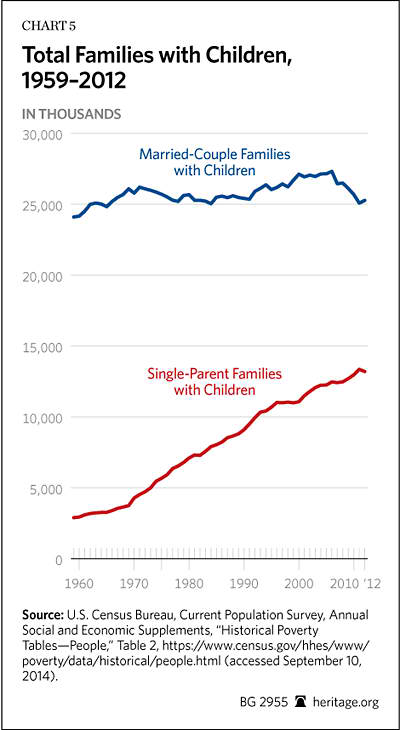
As Nautical chart five shows, there has been no pregnant increase in the number of married-couple families with children (both poor and non-poor) in the U.S. since 1965. Past contrast, the number of single-parent families with children has skyrocketed past nearly 10 1000000, ascent from iii.three million such families in 1965 to thirteen.ii meg in 2012. Since unmarried-parent families are roughly 4 times more than probable than married-couple families to lack self-sufficiency (and to be officially poor), this unravelling of family structure has exerted a powerful downward pull against self-sufficiency and substantially boosted the official child poverty rate.
Since the get-go of the War on Poverty, the absolute number of married-couple families with children in official poverty has declined, but as Chart 6 shows, the number of single-parent families in official poverty (or lacking cocky-sufficiency) has more than tripled, increasing from 1.vi million in 1965 to 4.eight million today. When the State of war on Poverty began, 36 pct of poor families with children were headed by unmarried parents; today, the effigy is 68 percent. [24]
The War on Poverty crippled marriage in low-income communities. As means-tested benefits were expanded, welfare began to serve as a substitute for a husband in the home, eroding marriage amid lower-income Americans. In addition, the welfare system actively penalized low-income couples who did ally by eliminating or substantially reducing benefits. As husbands left the home, the need for more than welfare to back up single mothers increased. The War on Poverty created a destructive feedback loop: Welfare promoted the reject of union, which generated the need for more welfare.
Today, unwed childbearing and the resulting growth of single-parent homes is the most important cause of official child poverty.[25] If poor women who requite birth outside of marriage were married to the fathers of their children, two-thirds would immediately be lifted out of official poverty and into cocky-sufficiency.[26]
The welfare state has also reduced cocky-sufficiency past providing economic rewards to athletic adults who do not work or who work comparatively piddling. The low level of parental work is a major cause of official child poverty and the lack of self-sufficiency. Even in adept economic times, the median poor family with children has just chiliad hours of parental work per yr. This is the equivalent of one adult working 20 hours per week. If the amount of work performed in poor families with children was increased to the equivalent of one adult working total-fourth dimension through the year, the poverty rate amongst these families would drop by ii-thirds.[27]
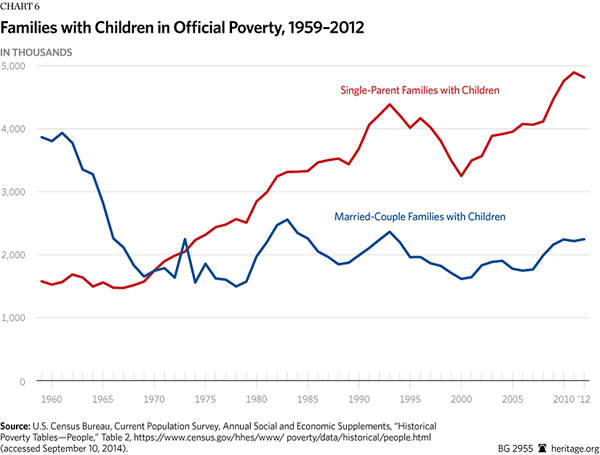
Conclusion
This lack of progress in edifice self-sufficiency is due in major part to the welfare system itself. Welfare wages war on social capital letter, breaking downward the habits and norms that lead to self-reliance, specially those of marriage and work. It thereby generates a design of increasing intergenerational dependence. The welfare state is cocky-perpetuating: Past undermining productive social norms, welfare creates a need for even greater assistance in the future.
Equally the War on Poverty passes the half-century marking, it is time to rein in the endless growth in welfare spending and render to LBJ'south original goals. As the economic system improves, total means-tested spending should be moved gradually toward pre-recession levels. Able-bodied, non-elderly adult recipients in all federal welfare programs should be required to work, prepare for work, or at least look for a chore as a condition of receiving benefits.
Finally—and near important—the anti-marriage penalties should exist removed from welfare programs, and long-term steps should be taken to rebuild the family in lower-income communities.
—Robert Rector is a Senior Research Fellow and Rachel Sheffield is a Policy Analyst in the Institute for Family, Community, and Opportunity at The Heritage Foundation.
[ane] Lyndon B. Johnson, "Annual Bulletin to the Congress on the State of the Matrimony," January 8, 1964, http://www.presidency.ucsb.edu/ws/index.php?pid=26787 (accessed September 8, 2014).
[2] The poverty figures for 1947 through 1958 are taken from Gordon Fisher, "Estimates of the Poverty Population Under the Current Official Definition for Years Before 1959," U.Southward. Department of Health and Homo Services, Office of the Assistant Secretarial assistant for Planning and Evaluation, 1986. The figures for 1953 and 1954 were interpolated. Copies of this document will exist made bachelor on request from the authors. These estimates are not official government figures.
[3] For instance, the poverty income threshold for a family unit of four including two children in 2013 was $23,624 per year. U.S. Census Bureau, "Preliminary Estimates of Weighted Average Poverty Thresholds for 2013," http://www.demography.gov/hhes/www/poverty/data/threshld/index.html (accessed September eight, 2014).
[4] Typically, only 3 pct of total ways-tested spending is counted past the Census as "income" for purposes of deriving the official poverty measure.
[v] See Robert Rector and Rachel Sheffield, "Understanding Poverty in the United States: Surprising Facts About America'southward Poor," Heritage Foundation Backgrounder No. 2607, September xiii, 2011, http://world wide web.heritage.org/inquiry/reports/2011/09/understanding-poverty-in-the-united-states-surprising-facts-almost-americas-poor, and Robert Rector and Rachel Sheffield, "Air conditioning, Cable TV, and an Xbox: What Is Poverty in the United states of america Today?" Heritage Foundation Backgrounder No. 2575, July xviii, 2011, http://www.heritage.org/inquiry/reports/2011/07/what-is-poverty?ac=one.
[6] Calcuated by the authors from U.S. Bureau of Labor Statistics, Consumer Expenditure Survey for 2012, http://world wide web.bls.gov/cex/home.htm#products (accessed September 8, 2014).
[7] The government surveys that provide data on the actual living conditions of poor Americans include the Residential Energy Consumption Survey, What We Eat in America, Food Security, the National Health and Diet Examination Survey, the American Housing Survey, and the Survey of Income and Program Participation. See U.S. Department of Energy, Energy Information Administration, Residential Energy Consumption Survey, http://www.eia.doe.gov/emeu/recs/ (accessed June 22, 2011); U.South. Section of Agriculture, What We Eat in America, NHANES 2007–2008, Table 4, http://www.ars.usda.gov/SP2UserFiles/Place/12355000/pdf/0708/Table_4_NIN_POV_07.pdf (accessed June 22, 2011); Mark Nord, "Food Insecurity in Households with Children: Prevalence, Severity, and Household Characteristics," U.S. Department of Agriculture, September 2009, http://www.ers.usda.gov/Publications/EIB56/EIB56.pdf (accessed September 7, 2011); U.South. Department of Health and Human Services, "About the National Health and Diet Examination Survey," http://world wide web.cdc.gov/nchs/nhanes/about_nhanes.htm (accessed September 7, 2011); U.Southward. Census Agency, Current Housing Reports, Serial H150/xi, American Housing Survey for the United States: 2011 (Washington: U.S. Government Printing Office, 2013), http://www.census.gov/programs-surveys/ahs/data/2011/h150-11.html (accessed September 8, 2014); and U.S. Census Bureau, Survey of Income and Program Participation, 2001 Console, Wave 8 Topical Module, 2003, http://www.bls.census.gov/sipp_ftp.html#sipp01 (accessed June 27, 2011).
[8] Unless otherwise noted, data on the physical civilities in poor households are calculated from the 2009 Residential Free energy Consumption Survey (RECS) conducted by the U.S. Department of Free energy, http://www.eia.gov/consumption/residential/data/2009/index.cfm?view=microdata (accessed September 8, 2014).
[9] U.S. Census Agency, American Housing Survey for the Us: 2011.
[10] The figures on nutrient consumption and hunger were calculated from U.S. Census Agency, Current Population Survey, December 2009 Nutrient Security Supplement. The December supplement information provide the basis for the household nutrient security reports of the U.S. Section of Agronomics.
[11] Katherine S. Tippett et al., Food and Food Intakes by Individuals in the United States, 1 Solar day, 1989–91, U.S. Department of Agriculture, Agricultural Research Service, September 1995, http://www.ars.usda.gov/SP2UserFiles/Place/12355000/pdf/csfii8991_rep_91-2.pdf (accessed September 7, 2011). More contempo data are bachelor from the authors upon asking.
[12] Bernard D. Karpinos, "Electric current Peak and Weight of Youths of Military Age," Human Biology, Vol. 33 (1961), pp. 336–364. Recent data on young males in poverty provided by the National Eye for Health Statistics of the U.Southward. Department of Health and Human Services, based on the second National Wellness and Nutrition Examination Survey.
[xiii] Unless otherwise noted, figures on the housing of poor households are taken from U.Southward. Demography Bureau, American Housing Survey for the The states: 2011.
[14] U.S. Department of Housing and Urban Development, Office of Community Planning and Development, The 2009 Almanac Homeless Assessment Study to Congress, June 2010, p. 8, http://www.hudhre.info/documents/5thHomelessAssessmentReport.pdf (accessed June 22, 2011).
[15] Kees Dol and Marietta Haffner, Housing Statistics of the European Union 2010, Netherlands Ministry building of the Interior and Kingdom Relations, September 2010, p. 51, Table 2.1, http://abonneren.rijksoverheid.nl/media/dirs/436/data/housing_statistics_in_the_european_union_2010.pdf (accessed September seven, 2011), and U.South. Department of Energy, 2005 Residential Energy Consumption Survey, Consumption & Expenditures Tables, Summary Statistics, Table US1, Part two, http://world wide web.eia.gov/emeu/recs/recs2005/hc2005_tables/c&e/pdf/tableus1part2.pdf (accessed September 7, 2011).
[16] Lyndon B. Johnson, "Proposal for a Nationwide State of war on the Sources of Poverty," March 16, 1964, http://www.fordham.edu/halsall/mod/1964johnson-warpoverty.html (accessed August 27, 2009).
[17] Johnson, "Annual Message to the Congress on the State of the Matrimony," Jan viii, 1964.
[18] Ibid.
[xix] President Lyndon Johnson, quoted in David Zaretsky, President Johnson's War on Poverty: Rhetoric and History (Tuscaloosa: University of Alabama Printing, 1986), p. 49.
[20] Data bachelor from the authors upon request.
[21] James T. Patterson, America's Struggle Against Poverty 1900–1994 (Cambridge, MA: Harvard University Press, 1995), p. 128.
[22] U.Southward. Department of Education, National Eye for Instruction Statistics, Assimilate of Educational Statistics, Table 122, "High school graduates, by sex and control of school: Selected years, 1869–70 through 2021–22," http://nces.ed.gov/programs/digest/d12/tables/dt12_122.asp (accessed September 8, 2014).
[23] The welfare reform legislation enacted in 1996 had a meaning positive effect in decreasing welfare dependence, increasing cocky-sufficiency, and reducing official poverty among single mothers. Subsequently remaining largely static for 35 years, the percentage of unmarried-mother families that lacked self-sufficiency dropped sharply from 42 percent in 1996 to 33 percent in 2000. However, most of these gains have been outset by the erosions of the reform's work requirements later on 2001 and by the weakness of the U.S. economic system after 2007. Finally, and most important, the reforms have been overwhelmed by the growth of additional poverty-prone single-parent families since 1996.
[24] U.S. Census Bureau, Current Population Survey, Annual Social and Economical Supplements, "Historical Poverty Tables—Families," Tabular array iv, http://www.census.gov/hhes/www/poverty/information/historical/families.html (accessed September 11, 2014) The poverty charge per unit of single-parent male person-headed families between 1959 and 1973 is assumed to equal the 1974 rate of 15 per centum. This assumption has no pregnant effect on the results.
[25] Out-of-wedlock childbearing is non the same thing as teen pregnancy; the overwhelming bulk of non-marital births occur to young adult women in their early twenties, not to teenagers in high school.
[26] Robert E. Rector, Kirk A. Johnson, Patrick F. Fagan, and Lauren R. Noyes, "Increasing Marriage Would Dramatically Reduce Child Poverty," Heritage Foundation Middle for Data Analysis Written report No. CDA03-06, May 20, 2003, http://www.heritage.org/Research/Family/cda0306.cfm.
[27] Robert Eastward. Rector and Rea S. Hederman, Jr., "The Role of Parental Work in Kid Poverty," Heritage Foundation Centre for Information Analysis Report No. CDA03-01, January 29, 2003, http://world wide web.heritage.org/Research/Family/cda-03-01.cfm.
Authors

Rachel Sheffield
Former Policy Analyst, DeVos Center for Religion and Civil Society, The Found for Family, Community, and Opportunity

Source: https://www.heritage.org/poverty-and-inequality/report/the-war-poverty-after-50-years
Posted by: dreweswhatitat.blogspot.com

0 Response to "How Much Money Has The Federal Government Spent On The War On Drugs"
Post a Comment